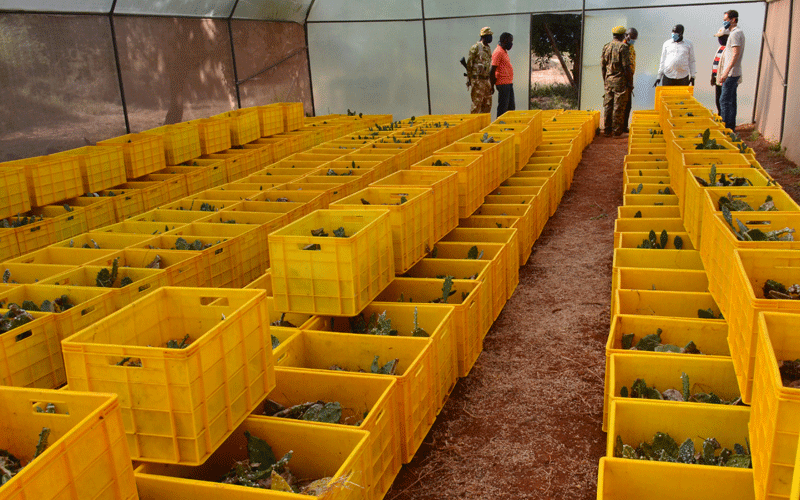KWS unveils magic bullet to kill invasive weed in Tsavo park

Isam Latoti
In a quiet edge of Tsavo National Park at Bachuma area along Nairobi-Mombasa Highway is a greenhouse ringed by tall trees.
Inside the greenhouse are over 300 yellow crates with thousands of leaves from prickly pear, a cactus plant.
Clinging on the surface of each leaf is white fluff-like substance. It is this white substance that scientists believe holds the key for total eradication of Opuntia Stricta, a notoriously resilient invasive species in Tsavo Conservation area (TCA).
Opuntia, commonly known as prickly pear, is a type of drought-resistant cactus that does well in warm weather and sandy soil. Its fruits have got sharp thorns where it derives its name.
“This offers us with a significant breakthrough in eradicating prickly pear that poses a threat to habitat for wildlife in both protected and semi-protected areas,” said the Principal Secretary for Wildlife Prof. Fred Segor.
The PS was speaking on Wednesday while touring the Bachuma greenhouse, Tsavo’s laboratory for breeding the insects.
The rare excitement in his voice betrays the general upbeat mood by Kenya Wildlife Service (KWS) and stakeholders in conservation arena over this achievement.
The white fluff are insects called cochineal. They prey on prickly pear by sucking juices from succulent leaves and stems.
The cactus becomes dehydrated, shrivels and eventually dries up. It does not regenerate.
Use of insects in Tsavo as biological control is not by default. Segor says KWS has spent years collaborating with stakeholders to find a workable solution to effectively deal with the menace of prickly pear.
As a plant, this cactus is one of the most aggressive non-native invasive species in Kenya.
Already, 120,000 hectares of grassland in Tsavo East National Park are under threat from Opuntia Stricta.
This land is approximately twice the size of Nairobi County. Experts warn such spread, if unchecked, will exert enormous pressure on existing habitat leading to reduction of pastures for wildlife and other plant species.
Segor says the insects have not only proved effective but are safe. 
“Possible environmental impacts from these insects have been considered. It is a safe method that is friendly to other elements in the habitat except the targeted species,” he said.
After the breeding the aphids in the greenhouse, the infested leaves are transferred to the field and deposited in a cactus bush.
Weeks later, the aphids spread throughout the whole bush and suck the life out of the plant.
Already, the insects have been introduced to 25,000 hectares of Tsavo lands where the prickly pear appears.
This is 20 per cent of the total area under the infestation. The insects will be dropped in cactus bushes on the remaining 80 per cent.
David Kimutai, acting Senior Research Scientist for TCA says the aphids are an effective control to the prickly pear.
“Once the aphids stick to the leaves, they don’t let go. They suck all saps. The bush shrivels completely,” he says.
That this cacti has a most potent regenerative abilities is not in doubt. Inside the greenhouse where scientists from KWS and David Sheldrick Foundation are working to breed the insects, a baby leaf struggles to germinate from a dying mother leaf infested with aphids.
Neville Sheldrick, from David Sheldrick Foundation, says the tenacity of prickly pear to regenerate cannot be understated.
“The extraordinary regeneration abilities makes this plant a real headache to deal with,” he notes.
Earlier efforts to contain opuntia have been futile. In 2010, a climate change adaptation project funded by Parks Canada experimented on physical control method.
This entailed cutting, uprooting and burying the cacti bushes in a deep pit.
Sadly, the project failed to yield expected results. Despite the huge labour, the team involved managed to clear an area of 100 hectares from over 100,000 hectares within six months. Worse, the cacti buried in the pits started germinating instead of rotting.
The biological control method is hailed as environmental friendly, cost effective and better in long-term suppression of cacti.
Experiments by Kenya Agriculture Research Institute (KARI) and Center for Agricultural Bioscience International (CABI) show the insects are not harmful to a new environment they are introduced to.
This method has successfully been used in ranches including Ol Jogi in Laikipia County and Soysambu in Nakuru County.
These insects are very particular on the cactus plant they feed on.
“It only feeds on this type of prickly pear. The rest are not affected by this biological control,” says Neville.
The cactus plant was introduced in Tsavo in the 1890’s by railway construction workers as fences to shield them from wild animals. Since then, it has spread to many areas within the park.
Other parks that have reported presence of prickly pear include Amboseli and Meru National Park.



